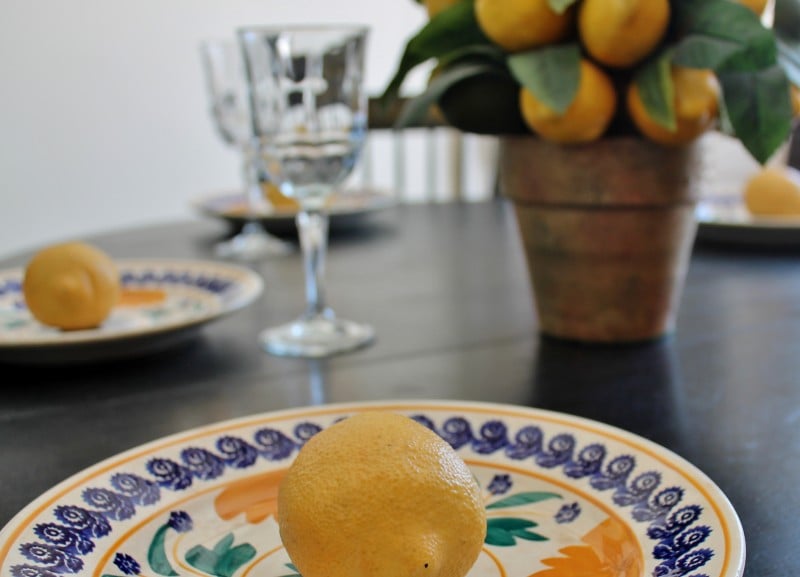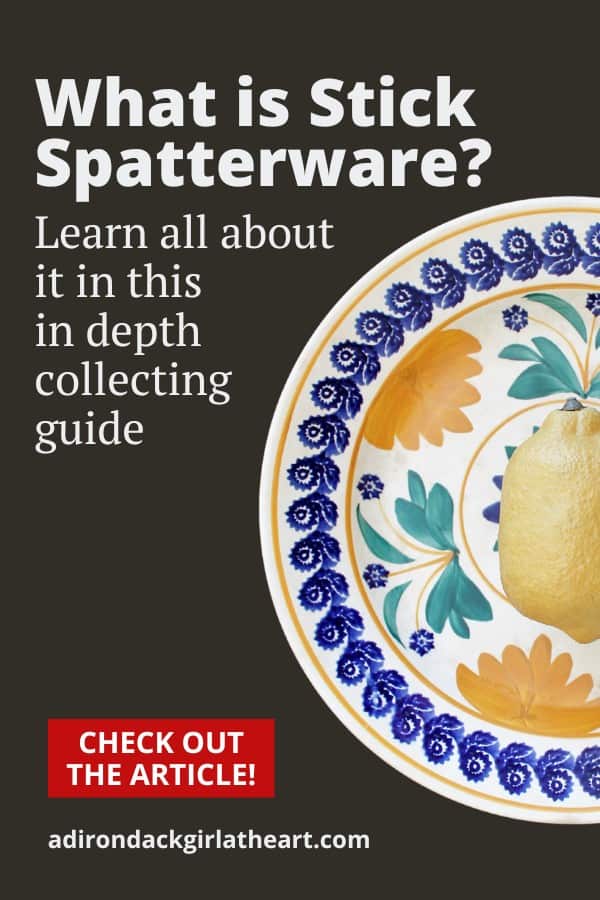A Stick Spatterware Guide: History & Values
I recently bought several pieces of stick spatterware china. Although I’ve bought and sold several pieces over the years, I was unfamiliar with the historical background. I decided it was time to learn a thing or two about this lovely collectible.

Like transferware, another popular type of dinnerware, spatterware was developed in Staffordshire, England, in the late 18th century. We Americans, particularly the Pennsylvania Dutch, soon fell in love with its bright, cheery colors and simple designs.
Viewed for years as a form of folk art because of it’s beautiful simplicity, it was in fact produced assembly line fashion in well-established potteries, like Enoch Woods and Wedgwood.
The popular style spread to other parts of Europe where it was also exported to America.

The pieces pieces in this post were manufactured in Holland by Societe Ceramique Maestricht.
In business from 1836 to 1969, they operated in an area well known for its earthenware production. Coarser and more porous than porcelain, it was intended for every day, utilitarian use.

The phrase, “Made In” gives us a clue to when they manufactured the plates. We know that the U.S. passed a tarriff law in 1891, requiring foreign manufacturers to label their products with the country of origin.
Thirty years later, an amendment required addition of the words, “Made In.” Thus the plates date to some time after 1921, but before 1969 when the company went out of business. My sense is that they are no newer than the 1940’s.
Dealers often use the terms, spongeware and spatterware interchangeably, but from what I can tell, there are actually three categories to be discerned:
- Stick spatterware
- Spatterware
- Spongeware
Many pottery experts believe the decorating process had nothing to do with the “spattering” of paint. In fact, all three types likely involved the sponging of paint.
1. Stick Spatterware

My plates fall into the first category of stick spatterware. Artisans created the cobalt blue decoration around the edge of the plate cut sponge attached to the end of a stick.
The artist would dip the end of the sponge into paint and then “stamp” the image onto the earthenware plate.

To decorate the center of the plate, the artist would have hand-painted the floral design with a paint brush, free style. Other pieces might be decorated with hand-painted folk art designs (e.g., a birds, tulips, or houses) or with a transferware design.
2. Spatterware

Spatterware has the type of decoration you see above: tiny dots of paint on the edges (the “spatter”) with a central folk-art style figure (here, a “peafowl”). It is the earliest and most valuable of the three types we’re looking at.
Some have suggested that the tiny dots may have been (a) hand-painted one-by-one, (b) blown on via a pipe of some sort, or (c) flicked on via a brush. No one really knows.
The piece above is listed for $95.00 on Etsy–an extremely low price because it has some condition issues. Single dinner plates run into the several hundred, even thousands of dollars.
Blue is the most common color and the peafowl the most common figure, making them slightly less valuable. Among the most coveted pieces are those with rainbow stripes of spatter in rare shapes like pitcher and bowl sets.
3. Spongeware

Spongeware is, I believe, the American response to European spatterware. Americans who could not afford imported spatterware, could likely afford spongeware made in America.
It is easily identified by its obviously sponged surface, usually with one color (often blue), in a random pattern.
My feeling, after doing some pretty extensive reading, it that American spongeware has little in common with European spatterware. The body, made of stoneware, rather than earthenware, is heavy. The decoration is really quite crude, and its surface is salt glazed.
It’s really an entirely different animal. But as I mentioned earlier, the terms spatter and sponge are used interchangeably for all three of these types of pottery.
Spongeware is still being made in America
by companies like Bennington Pottery (VT).
An Anomoly

Now that I’ve got everything nicely cleared up, I’ll throw a wrench in our tidy definitions.
This earthenware plate, which bears the same Maestricht backstamp as my stick spatter plates (as seen above) also falls into the spatter/spongeware category, despite the fact that it contains no sponged decoration at all(!).
It does however reflect the same bright cheeriness of European spatterware with its hand-painted decoration, and it is made from the same utilitarian earthenware. I would value this plate at about $15.00.
Stick Spatterware Value

I’m still not quite certain of the value of these plates. Because they are 20th century pieces, rather than 19th century, they won’t have huge value, though I do believe they have strong decorative value.
If I had to guess, I’d say they are worth about $12-15.00 each, but they would certainly brighten any room in the house.
Thanks for stopping by–
If you enjoyed this post, subscribe today
and get a FREE copy of my eBook:
Bye for now,
I’d love it if you’d pin me!

Good Sources of Additional Info:
Ceramics Collector: Gold at the End of Rainbow Spatterware
History of Spongeware Plates





Great, informative post, Diana. I do not collect collect spatterware, but the cheerful plates you have (keyword – plates!) and the manner you’ve styled them, sure make it enticing!
Thanks, Rita! Appreciate the encouragement 🙂
Great Job ! I LOVE dishes.and have tooo many! I learned a lot by reading today. Living in Manheim, Pa. I can see Pa. Dutch in these patterns . As I was reading I came on the pea fowl (they run around free range on farms here today) and being a lover of birds, decided that I needed plates with birds, till I red the rest! Thank You for all the information.
Diana, this is an excellent post. Thank you for sharing these pretty finds as well as all the useful, interesting information. Well done! The plates are charming.
How interesting! I love those Dutch dishes!
Diana, interesting to read the history as I wasn’t familiar with it–love the pieces you scored!
Thanks so much Cecilia 🙂 They are beautiful, aren’t they?
This is so interesting. It’s nice to know the history of these items. I really like the bright cheerful colors they used.
What an informative post. The patterns are really beautiful. It is amazing how many different techniques are/were used to decorate china. Thanks for sharing, Diana.
So, so pretty! I have to say that the first plate is not exactly “my colors” but I LOVE it! Thanks for all the great history and background info! xo Kathleen Charm Bracelet Diva {At Home}
I love that spongeware water jug! Thanks for all the great info. It always fun to learn new things. Now I’ll be able to recognize spatterware if I see it.
You’re welcome, Tuula 🙂 Be sure to let me know if you find some–
I know so little about dishes and glassware that I greatly appreciate posts like these at your blog. You are a great source of information, and your pics are always top notch! Thanks!